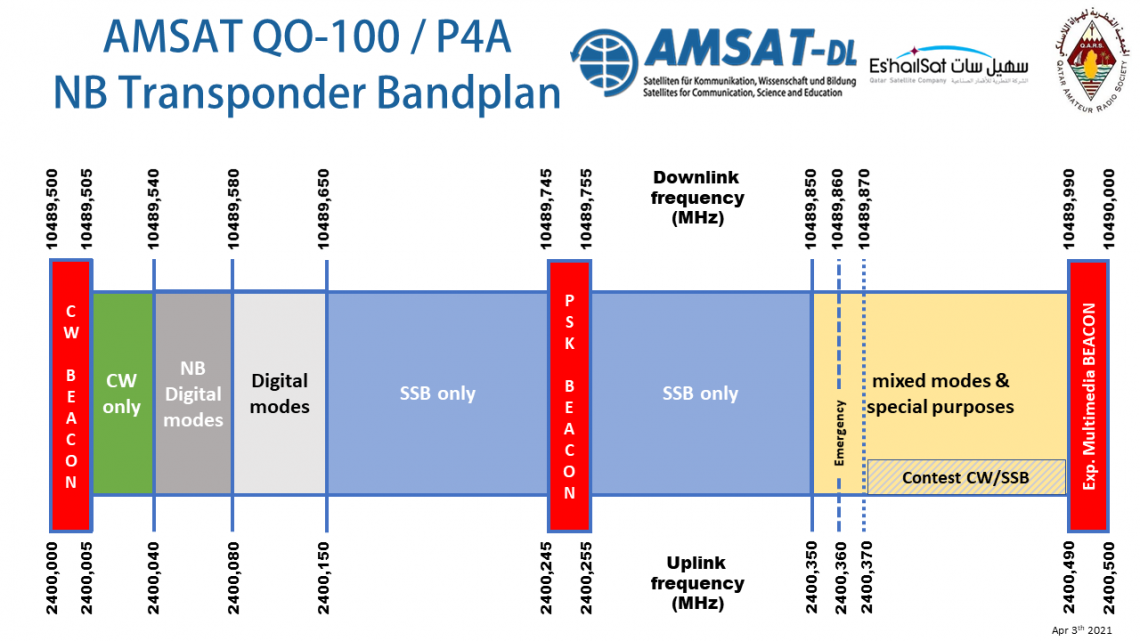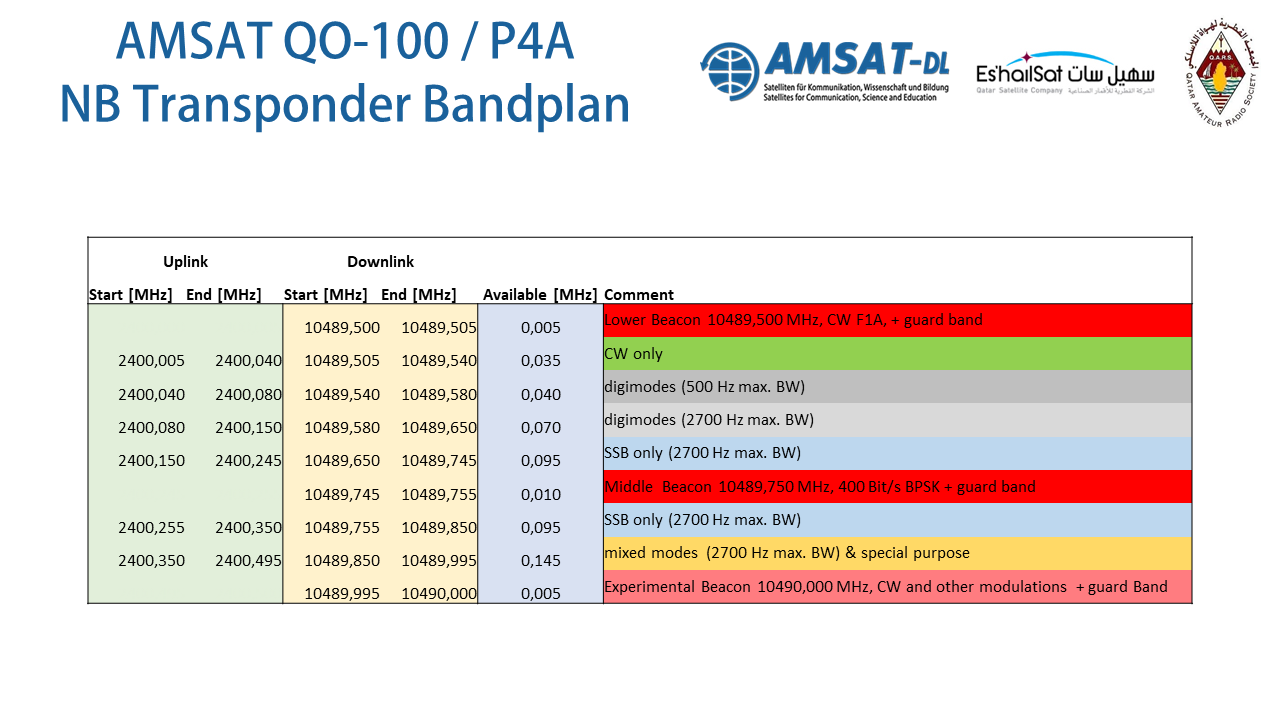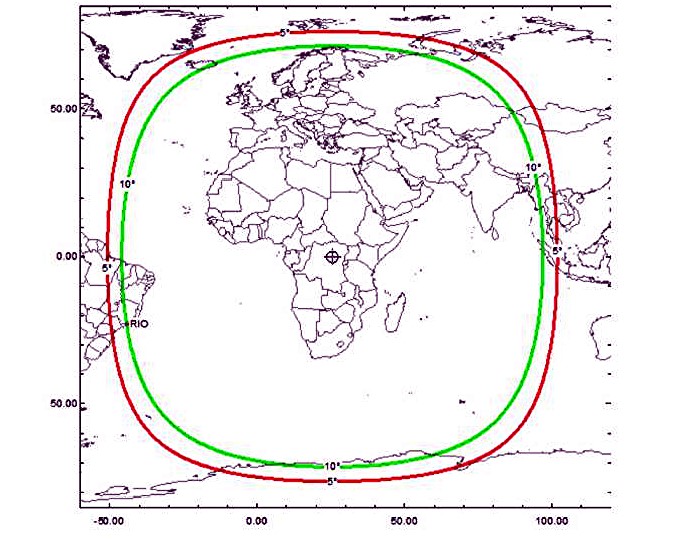The first geostationary amateur radio satellite (P4-A) on Es’hail-2 is a joint project of the Qatar Satellite Company (Es’hailSat), the Qatar Amateur Radio Society (QARS) and AMSAT Deutschland (AMSAT-DL).
Information on the QO-100 transponder / Es’hail-2 satellite
QO-100 is an amateur radio payload which is integrated on the Es’hail-2 satellite as a so-called “hosted payload”. Es’hail-2 is a telecommunications satellite from Qatar, which has a geostationary orbit with a position at 26° East. It was launched on November 15, 2018.
Es’hail is the Arabic name for the star Canopus.
QO-100 stands for “Qatar-OSCAR 100”. OSCAR is short for “Orbiting Satellite Carrying Amateur Radio”. The number 100 is a sequence number and therefore means that it is the one hundredth satellite with a recognized amateur radio payload in orbit at the time of successful commissioning. Traditionally, AMSAT assigns a new OSCAR number as soon as a satellite meets the requirements.
The amateur radio payload consists of 2 transponders: A narrowband transponder for SSB/CW and other transmission types, which must not exceed a bandwidth of 2.7kHz. The second transponder is a wideband transponder, which is mainly used for digital amateur radio television in DVB-S2 format. QO-100 is not only the first geostationary amateur radio satellite, but also the first OSCAR with such a DATV transponder.
Peter Gülzow DB2OS is the spiritual father of QO-100, he started the project at a lecture in Doha/Qatar at the end of 2012 and was the project leader for AMSAT-DL. Together with the Qatar Amateur Radio Society (QARS) and the satellite operator Es’hailSat (Qatar Satellite Company), the AMSAT-DL team specified the amateur radio payload under the project name AMSAT Phase 4-A and made the design specifications. At AMSAT, Phase 4 stands for geostationary satellites and “A” because it is the first of its kind.
The two amateur radio transponders differ significantly from conventional television transponders and are therefore not comparable, if only because of the amateur radio uplink in the 2.4 GHz range and the antennas on the satellite, which do not illuminate individual countries but the entire visible globe.
The amateur radio load, as well as the entire Es’hail-2 satellite, was financed by the government of Qatar.
The transponders were built by the main contractor for the entire satellite, Mitsubishi Electric Corporation (MELCO) in Japan. AMSAT-DL experts were involved in all phases, right up to the critical design review directly at the manufacturer in Japan and the official launch on February 14, 2019.
Es’hail-2 itself is controlled from Qatar. AMSAT-DL has installed the ground equipment required for QO-100 in the Satellite Control Center (SCC) built in Qatar and in Bochum. A further backup station is located at QARS in Doha. Currently, the DATV beacon is sent to the satellite from Qatar, while the LEILA beacons of the NB transponder are continuously sent from the AMSAT-DL headquarters at the Bochum Observatory. AMSAT-DL is in direct contact with the control center in Qatar via a “red telephone”.
Technical details
On a 250 kHz wide band, radio amateurs can communicate and experiment simultaneously in SSB, CW or narrowband digital modes. The uplink is on 2.4 GHz, the downlink in the 10 GHz band.
| Frequencies of the narrow band (NB) transponder (bandwidth 250 kHz) | ||
| Uplink | 2400.000 – 2400.500 MHz | Polarization RHCP |
| Downlink | 10489.500 – 10490.000 MHz | Polarization vertical |
Band plan


| Frequencies wide band (WB) transponder (bandwidth 8 MHz) | ||
| Uplink | 2401.500 – 2409.500 MHz | Polarization RHCP |
| Downlink | 10491.000 – 10499.000 MHz | Polarization horizontal |
Special authorization 13cm band
In Switzerland, a special license from OFCOM is required for the operation of transmitters on 2.4 GHz. The USKA has defined the procedure with OFCOM for applying for the necessary special license. It is issued quickly and unbureaucratically to all HB9 users on request.
Details on how to obtain the special permit (new version 2021!):
Operation
The Es’hail-2 satellite has been in operation since 15.11.2018. This geostationary satellite will enable 24-hour uninterrupted radio operation throughout Europe and Africa, from the east coast of South America to the Indian subcontinent, from Iceland to the islands in the Indian Ocean. The antennas can be permanently aligned for this purpose; no tracking is necessary.
Coverage of the satellite

Minimum setup for SSB connections:
| RX Antenna | 60-90 cm SAT-TV dish |
| Receiver |
LNB with power injector and DVB-T dongle + SDR software (for example SDR#)oder 3 cm LNA with downconverter to 70cm |
| Transmitter | 10W PEP in 60-90 cm dish plus upconverter from 144 MHz |
Minimal-Setup für DATV (DVB-S2) Verbindungen:
| RX Antenna | 60-90 cm SAT-TV dish |
| Receiver |
modified LNB with standard satellite receiver box (DVB-S2)oder modified LNB with PCI DVB-S2 cards for PC use |
| Transmitter | 25W PEP in 2.4m dish plus DVB-S2 modulator for a 2MSym/s videostream |
Sources and information
| Link Bandplan: | https://amsat-dl.org/neuer-qo-100-bandplan/ |
| Link: | https://funkperlen.blogspot.com |
| Link: | https://www.amsat-hb.org |
| Link: | https://amsat-dl.org/eshail-2-amsat-phase-4-a |
| Presentation: | Es’hail-2 AMSAT DL |
| Presentation: | Es’hail-2 Leaflet |
| Solutions: | https://www.lutz-electronics.ch/amateurfunk/satellitenfunk/ |
| https://shop.kuhne-electronic.de/kuhne/de/onlineshop/EsHail-2/ | |
| Special authorization for the 13cm band (new version 2021): | Special authorization QO 100 2021Authorization QO 100 2021 FR |
| Template 13cm application (for the SwAC Contest) | Anfrage 13cm SSB (Word document German) Demande 13cm SSB (Word document French) Richiesta 13cm SSB (Word document Italian) Link SwAC page |
Further contents:
- Frequencies and band plans
- Repeater Map (this page)
- 60m
- Es’hail-2 / AMSAT QO-100 (this page)
